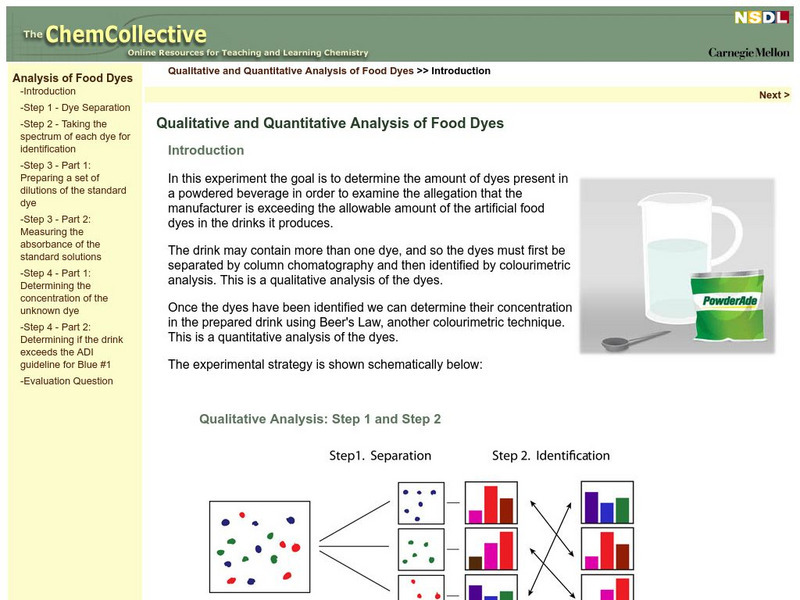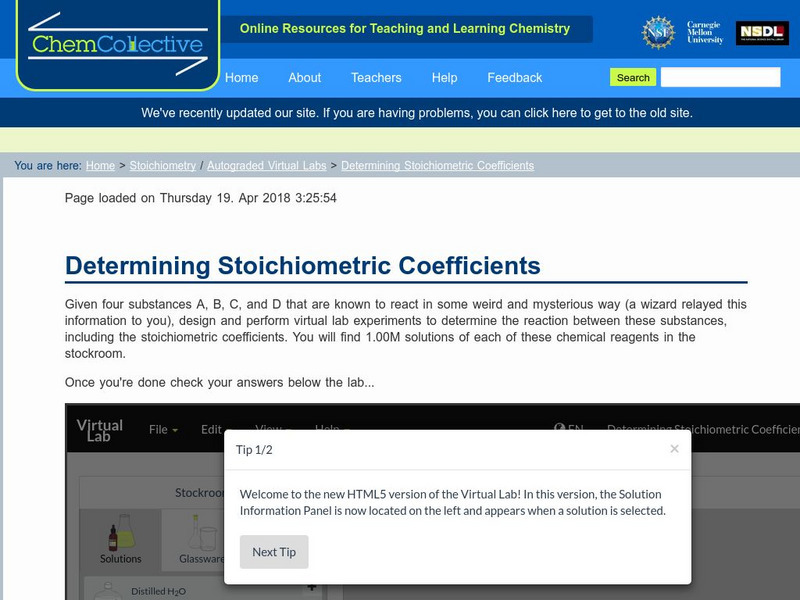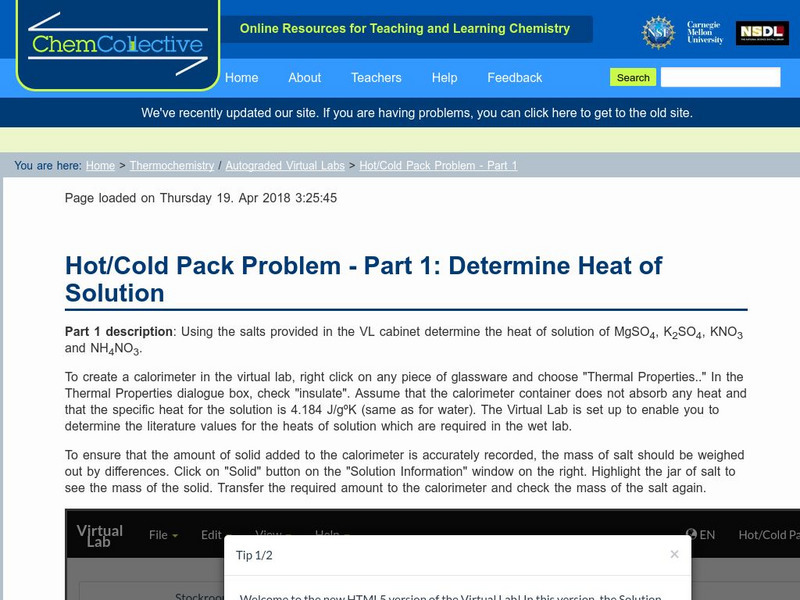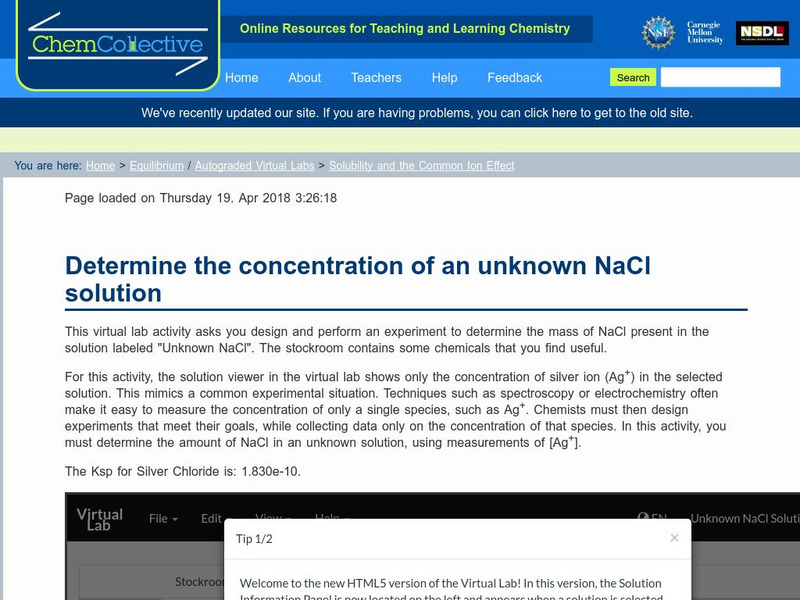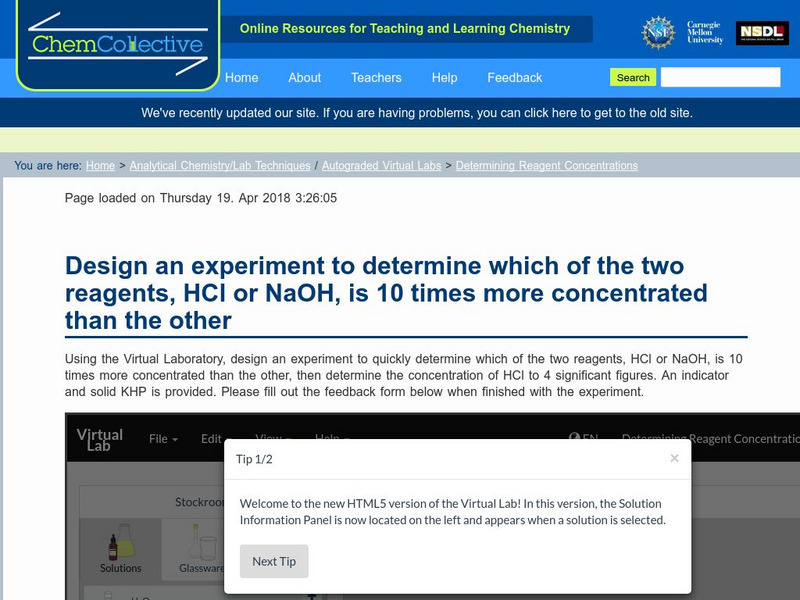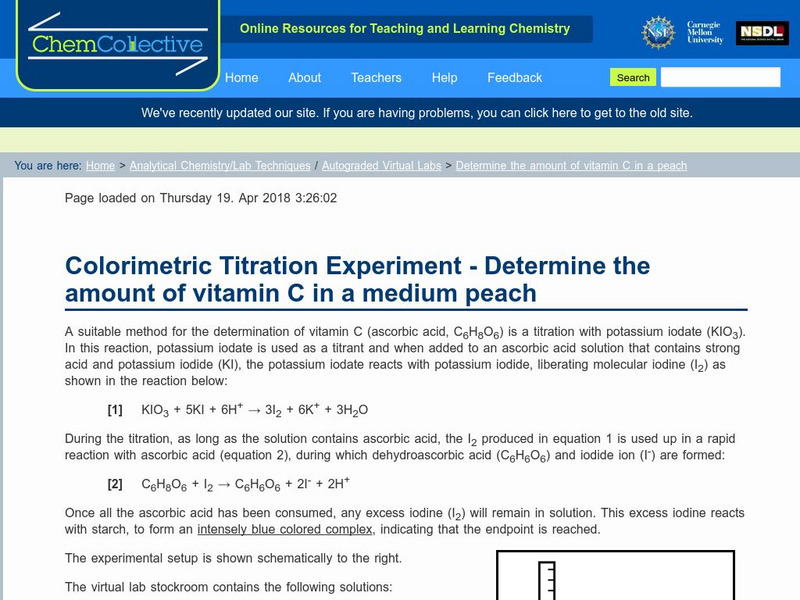Curated OER
Frogguts
Students comprehend the basic anatomy of the frog and prepare themselves for dissection. They work through the virtual dissection. Students complete the worksheet and begin to assemble the frog skeleton. They are assigned frog...
Concord Consortium
Concord Consortium: Stem Resources: Changes in the Environment
An activity to help students understand that as the environment changes, plants and animals must evolve to stay alive. Students watch as a mystery plants grow in a changing environment to see if they will evolve or go extinct.
Chemistry Collective
Chem Collective: Camping Problem
Measure the enthalpy of a reaction and then create a solution warm enough to cook food.
Carnegie Mellon University
Chem Collective: Acid Mine Drainage
Students explore the chemistry behind the causes and effects of acid mine drainage on a modeled river. In this activity, students examine the chemistry of acidic mine runoff and its effects on river water.
Carnegie Mellon University
Chem Collective: Arsenic in Drinking Water
Set in the context of ground water contamination in Bangladesh, this stoichiometry and analytical chemistry activity examines the issues around identifying wells contaminated with arsenic.
Carnegie Mellon University
Chem Collective: Dna Binding Dyes Scenario
This activity explores the equilibrium of dyes that self-assemble into DNA templates. Students use knowledge of equilibrium and quantitative spectroscopy to explore different dyes that bind selectively to DNA molecules. In this activity,...
Carnegie Mellon University
Chem Collective: Meals Ready to Eat
While camping on the Appalachian Trail, a storm dampens all the fire wood and you must design a chemical reaction to heat your meal. In this activity, students design an experiment in the virtual lab to determine the heat of reaction for...
Carnegie Mellon University
Chem Collective: Qualitative and Quantitative Analysis of Food Dyes
An interactive tutorial to determine the amount of dyes present in a powdered beverage in order to examine the allegation that the manufacturer is exceeding the allowable amount of the artificial food dyes in the drinks it produces.he...
PBS
Pbs: On Fire
A virtual lab exploring the topic of combustion. Students will work through the equation of combustion by looking at the molecules involved. Students will also complete a flame experiment,
Chemistry Collective
Chem Collective: Metals Density Problem
In this activity, students use the virtual lab to identify three unknown metals by measuring their density and comparing their measurements to the densities of known metals. In this randomized version, each student designs and performs...
Chemistry Collective
Chem Collective: Determining Reactants and Products in a Solution of Dna
In this limiting reagents problem, students are given specific concentrations of DNA solutions and are asked to predict what products and reactants will remain after a specific volumes are mixed and reaction has occurred.
Chemistry Collective
Chem Collective: Determine the Concentration of Unknown Silver Nitrate Solution
In this limiting reagents problem, students are asked to determine the amount of silver nitrate dissolved in a solution by performing a reaction with solid NaCl. In this randomized activity, each student is given a different unknown...
Chemistry Collective
Chem Collective: Determining Stoichiometric Coefficients
Students use the virtual lab to determine how four unknown substances react with each other including their stoichiometric coefficients. In this randomized activity, each student receives a different reaction and students can check their...
Chemistry Collective
Chem Collective: Coffee Problem
In this activity, students use knowledge of specific heat capacity to mix together hot coffee and cold milk to create a solution of coffee at a desired temperature. In this randomized problem, each student is given a different final...
Chemistry Collective
Chem Collective: Hot/cold Pack Problem: Part 1
Determine the heat of solution for various salts.
Chemistry Collective
Chem Collective: Unknown Weak Acid Problem
Perform an experiment to determine the pKa and concentration of an unknown acid.
Chemistry Collective
Chem Collective: Unknown Weak Acid Problem Bonus
Perform an experiment to determine the concentrations of a mixture of two acids.
Chemistry Collective
Chem Collective: Solubility and the Common Ion Effect
Determine the concentration of an unknown NaCl solution using the common ion effect.
Chemistry Collective
Chem Collective: Metal Ligand Binding
Use silver chloride to determine the binding constant for a metal ligand complex.
Chemistry Collective
Chem Collective: Determine the Concentration of the Unknown Strong Acid
Perform a titration using an indicator to determine the concentration of an HCl solution.
Chemistry Collective
Chem Collective: Designing a Buffer Solution With a Specific P H
Create a buffer solution at a specific pH using a weak acid and its conjugate base.
Chemistry Collective
Chem Collective: Determining the Concentration of an Unknown Solution
Using the Virtual Laboratory design, students perform an experiment to determine the concentration of the unknown HCl solution to four significant figures.
Chemistry Collective
Chem Collective: Determining Reagent Concentrations
Using the Virtual Laboratory, design an experiment to quickly determine which of the two reagents, HCl or NaOH, is 10 times more concentrated than the other.
Chemistry Collective
Chem Collective: Determine the Amount of Vitamin C in a Peach
Perform a titration experiment to determine the concentration of absorbic acid in one medium peach.







